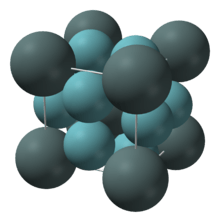Niobium-tin

Niobium-tin (Nb3Sn) or triniobium-tin is a metallic chemical compound of niobium (Nb) and tin (Sn), used industrially as a type II superconductor. This intermetallic compound is an A15 phase superconductor. It is more expensive than niobium-titanium (NbTi), but remains superconducting up to a magnetic flux density of 30 teslas [T] (300,000 G),[1] compared to a limit of roughly 15 T for NbTi.
Nb3Sn was discovered to be a superconductor in 1954. The material's ability to support high currents and magnetic fields was discovered in 1961 and started the era of large-scale applications of superconductivity.
The critical temperature is 18.3 kelvins (−254.8 °C; −426.7 °F). Application temperatures are commonly around 4.2 K, the boiling point of liquid helium at atmospheric pressure.
In April 2008 a record non-copper current density was claimed of 2,643 A/mm² at 12 T and 4.2 K (−268.95 °C; −452.11 °F).[2]
Practical use
Mechanically, Nb3Sn is extremely brittle and thus can not be easily drawn into a wire, which is necessary for winding superconducting magnets. To overcome this, wire manufacturers typically draw down composite wires containing ductile precursors. The "internal tin" process includes separate alloys of Nb, Cu and Sn. The "bronze" process contains Nb in a copper-tin bronze matrix. With both processes the strand is typically drawn to final size and coiled into a solenoid or cable before heat treatment. It is only during the heat treatment that the Sn reacts with the Nb to form the brittle, superconducting niobium-tin compound.[3] The powder-in-tube process is also used.[2][4]
The high field section of modern NMR magnets are composed of niobium-tin wire.
Some niobium-tin wires can be wound after heat treatment.
History
Nb3Sn was discovered to be a superconductor in 1954, one year after the discovery of V3Si, the first example of an A3B superconductor.[5] In 1961 it was discovered that niobium-tin still exhibits superconductivity at large currents and strong magnetic fields, thus becoming the first known material to support the high currents and fields necessary for making useful high-power magnets and electric power machinery.[6][7]
Notable uses
The central solenoid and toroidal field superconducting magnets for the planned experimental ITER fusion reactor use niobium-tin as a superconductor.[8] The central solenoid coil will produce a field of 13.5 teslas (135,000 G). The toroidal field coils will operate at a maximum field of 11.8 T. Estimated use is 600 metric tons (590 long tons) of Nb3Sn strands and 250 metric tonnes of NbTi strands.[9][10]
In 1986 it had been proposed for the Large Hadron Collider at CERN to use niobium-tin superconducting magnets instead of niobium-titanium, and thus avoid the requirement to cryogenically-cool the collider below the 4.22K limit with superfluid helium, but this option was not pursued in order to avoid delays while competing with the then-planned US-led Superconducting Super Collider.[11] Nevertheless, the planned future upgrade on LHC will eventually use niobium-tin, superconducting magnets.
See also
References
- ↑ "Limits of NbTi and Nb3Sn, and Development of W&R Bi–2212 High Field Accelerator Magnets". Office of Science, High Energy Physics, U.S. Department of Energy. 2006-09-01. Retrieved 2015-12-26.
- 1 2 "Record current with powder-in-tube superconductor". laboratorytalk.com. Retrieved 2008-09-06.
- ↑ R. Scanlan; A.F. Greene & M. Suenaga (May 1986). "Survey Of High Field Superconducting Material For Accelerator Magnets" (PDF). SSC-MAG-81 ; LBL-21549.
- ↑ J.L.H., Lindenhovius; Hornsveld, E.M.; den Ouden, A.; Wessel, W.A.J.; ten Kate, H.H.J. (2000). "Powder-in-tube (PIT) Nb3Sn conductors for high-field magnets" (PDF). Applied Superconductivity. 10 (1): 975–978. doi:10.1109/77.828394. Retrieved 2008-09-06.
- ↑ Matthias, B. T.; Geballe, T. H.; Geller, S.; Corenzwit, E. (1954). "Superconductivity of Nb3Sn". Physical Review. 95 (6): 1435–1435. doi:10.1103/PhysRev.95.1435.
- ↑ Geballe, Theodore H. (October 1993). "Superconductivity: From Physics to Technology". Physics Today. 46 (10): 52–56. doi:10.1063/1.881384.
- ↑ Godeke, A. (2006). "A review of the properties of Nb3Sn and their variation with A15 composition, morphology and strain state". Supercond. Sci. Technol. 19 (8): R68–R80. doi:10.1088/0953-2048/19/8/R02.
- ↑ "Results of the first tests on the ITER toroidal magnet conductor". Commissariat à l'Énergie Atomique. 2001-09-10. Retrieved 2008-09-06.
- ↑ G. Grunblatt; P. Mocaer, Ch. Verwaerde and C. Kohler (2005). "A success story: LHC cable production at ALSTOM-MSA". Fusion Engineering and Design (Proceedings of the 23rd Symposium of Fusion Technology). 75–79: 1–5.
- ↑ "Alstom and Oxford Instruments Team Up to Offer Niobium-Tin Superconducting Strand". Alstrom. 2007-06-27. Retrieved 2008-09-06.
- ↑ Rossi (head of the Magnet and Superconductor group at CERN, 2001–2011), Lucio (2011-10-25). "Superconductivity and the LHC: the early days". CERN Courier. International Journal of High-Energy Physics. CERN. Retrieved 2013-12-10.